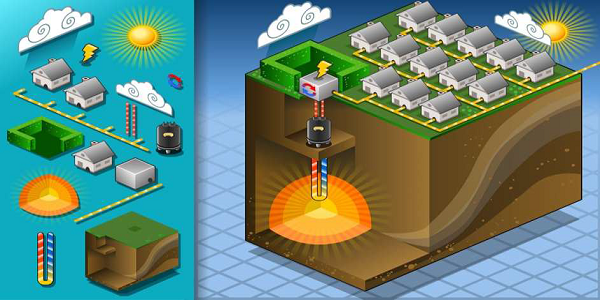
- Solar Energy - Introduction
- Solar Energy - Photovoltaic Effect
- Developing Solar Panel
- Solar Energy - Cell Efficiency
- Types of Photovoltaics
- Geothermal Energy
- Geothermal Energy - Introduction
- Geothermal Energy - Extraction
- Geothermal Energy - Geophysics
- Hydroelectric Power
- Hydroelectric Power - Introduction
- Hydroelectric Power - Turbine Types
- Hydroelectric Power Systems
- Hydraulic Ram Pump
- Renewable Energy Resources
- Renewable Energy - Quick Guide
- Renewable Energy - Resources
- Renewable Energy - Discussion
Geothermal Energy - Introduction
Geothermal energy refers to heat energy stored under the ground for millions of years through the earth formation. It utilizes a rich storage of unutilized thermal energy that exists under the earths crust.
Geothermal energy is site specific but can be very cheap especially when used for direct heating. It is a challenge to estimate power from this source since it occurs underground at extremely high temperatures.
The earths crust has immense heat (thermal) energy stored over millions of years. There exists a huge temperature difference between the earths crust and the surface. The temperature difference is known as geothermal gradient. This energy is sufficient to melt rock. The molten rock, called magma, at times erupts through cracks on earth surface as volcanoes. Geothermal energy is converted to produce to electricity.

The presence of geothermal deposits in form of hot geothermal fluid is a sign of a good site. The site should have a shallow aquifer to allow injection of water. The inherent geothermal product should be about 300o F.
Advantages of Geothermal Energy
The major advantages include −
No fuel is burnt since heat is derived from an abundant underground reservoir. The renewable energy source could solve the risk of running out of fossil fuels.
It has no emissions and produces 10% carbon dioxide, which is very little compared to the amount consumed by plants.
Unlike other sources of renewable energy (solar, wind and water), it is not affected by whether and will always be available throughout the year.
Geothermal energy is relatively less expensive especially when directly used, for example, as source of heat in greenhouses.
The only disadvantage of geothermal energy is the release of hydrogen sulfide identified by the signature rotten egg smell.
Enhanced Geothermal Sources (EGS)
In some geothermal sources, water is injected into the wells containing geothermal deposits. Inside these deposits, water gets superheated and hence changes into steam. Water is pumped down under very high pressure to expend rock fissures.
Some lower temperature geothermal energy is utilized directly as heat. Green houses may be supplied with this energy as temperature regulator. This technique is also used in fisheries and mineral recovery.